Solar Powered Rainwater Project – Completed?
The Solar Powered Rainwater Project began about eight months ago, although one might argue it is the culmination of my rainwater system dreams beginning in 2002. In any case, the system is essentially done, and it’s time to assess the results, and what we learned. Here are the original project goals:
- measure the daily average power needed to pump rainwater for household use
- design a solar power system to provide that power with at least 3 days of extra storage for overcast conditions
- allow for the rapid change back to commercial power during equipment failures
- keep the cost as low as possible
- develop additional expertise in the design and installation process
- collect data on the operation of such a system
Measuring Daily Use
First, I measured the power use of a 3/4-horse pump supplying household water for one week. This 1100-watt pump, running in short bursts, uses about 1300 watt-hours of power per day. Added to the power needed for a 30-watt ultra-violet water filter consuming 720 watt-hours, they consume a total of 2020 watt-hours per day. I didn’t know how much power the inverter itself would use. There is a power-saving feature on the inverter, but it couldn’t be used to power a ultra-violet water filter continuously. Therefore, the inverter is on all the time — consuming about 70 watts with no load. That adds an additional 1680 watt-hours. So instead of using the predicted 2020 watt-hours per day, the total is actually 3700 watt-hours. I’d say I missed this one by a mile.
One could greatly reduce this figure by running the UV filter on a separate smaller inverter, or even better, a DC supply. The big inverter could then run in “power-saver” mode — reducing its standby power consumption to about 30 watts. In this arrangement, the 24-hour power consumption (both UV filter and inverter power) could be reduced to as little as 1440 watt-hours for a total daily consumption of 2740 watt-hours — almost a 1000 watt-hour savings.
Three-day power for overcast conditions
In my original calculations, I predicted 2020 watt-hours per day to run the pump and UV filter. Accounting for an estimated inverter efficiency of 92%, the design called for 2195 watt-hours of storage per day. Batteries are not perfect, degrade at high temperatures and wear out faster if discharged more than about 50%. The estimated battery storage:
- Average daily Watt-hours * Days of Autonomy * Battery Temperature Multiplier / Battery Discharge Limit = Battery Bank Capacity in Watt-hours
Substituting numbers: 2195 * 3 * 1.19 / .5 = 15,672 Watt-hours of storage
Golf-cart batteries are attractive because they are inexpensive per unit of energy. When eight 6-volt batteries are wired in series, they yield a 48-volt, 10,500 watt-hour battery. I decided to start with that and add more if needed.
A week of overcast conditions provided a test. Solar panels generate some power even in overcast conditions, providing some of the daytime power needs. Nevertheless, the battery bank was approaching 48 volts (down from 52 to 54 volts when charged) by sunset of the second day. Since 48.8 volts is considered 50% discharge, they were just about depleted. I came close to the original estimate though. With only 10,500 watt-hours of storage installed (instead of the designed 15,672) and an additional 1680 watt-hours of power consumption each day by the inverter, my estimates were close. Installing an additional battery bank and reducing the inverter standby power by using the power-saver mode would make up the difference.
Rapid change back to commercial power
Success! By installing a transfer switch between the inverter and breaker box, we have the ability to not only rapidly change back to commercial power, but do so on a circuit-by-circuit basis. In addition, the inverter/charge controller/battery charger can sense when batteries are depleted and automatically switch to commercial power while applying a fast charge to the battery bank. Once the charge is complete, the inverter automatically changes back to battery power. This maximizes use of solar power while maintaining the reliability of a commercial grid.
Low Cost
Original cost estimates were $3500, but additional solar panels, a custom battery cart, a transfer switch and other incidentals raised the cost to just over $5000 dollars excluding labor.
- Inverter/Charge Controller/Battery Charger – $1200
- 6-250 watt solar panels – $1900
- 48-volt battery bank (golf cart batteries) – $860
- Battery cart (custom-made welded steel) – $300
- Transfer switch, panel combiner, DC breakers and other incidentals – $840
Develop Expertise
Big win here. The system has been operating since July, and daily data indicators like battery voltage and battery power consumption have been enlightening. The digital power meter shows, under varying conditions, how the system is working. It also uncovered a problem. The Maximum Power Point Tracking (MPPT) charge controller is supposed to maximize the transfer of power from panels to batteries while preventing them from overcharging. I have seen battery voltages exceeding 60 volts when they shouldn’t be higher than 59.2 volts. Contacting the manufacturer, they recommended changing an internal setting on the charge controller. The adjustment helped, but I will have to monitor it a while.
Collect Data
I began collecting data the day the solar power system was operational. By monitoring the battery voltage each morning, I could see that two panels were just keeping up with the UV filter and inverter. Two more panels were added, and the battery was over-voltage on the sunniest days. With a consistent battery usage of about 1100 watt-hours per day, there was ample production to replace that energy and power the UV filter and inverter for 24 hours. After adding the last two panels and the buried rainwater system power cable, I began powering the rainwater system. With the exception of about a week of continuous overcast, it has been exclusively solar-powered ever since. Battery usage increased to about 2200 watt-hours per day, and there is adequate panel production to independently power the pump (actual consumption: 1500 watts) at peak sun.
Lessons learned and next steps
- Small, continuous loads can consume as much or more power than short, high-current loads.
- Solar panels produce some power during overcast days.
- Transfer switches allow selective powering of loads to maximize use of solar power.
- Metering is essential to understanding system performance.
If we have an especially dry or cold winter, I will shut the rainwater system down. This will provide a real-world test of the system powering a 3000-watt well pump. Will there be enough solar production during the short days of winter to keep up? I also plan to work on an alternative power source for the UV filter. In the meanwhile, it can be switched to commercial power (love that transfer switch!) so I can use the power-saver mode on the inverter. I may also add another battery bank, but that’s another $1200 expense. We’ll see. Otherwise, I’m declaring victory!

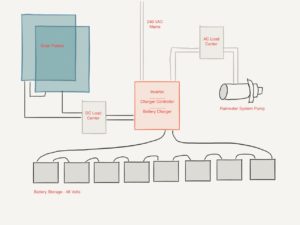
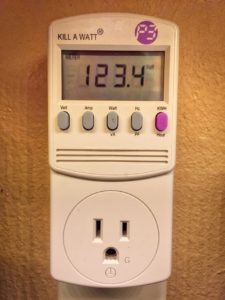
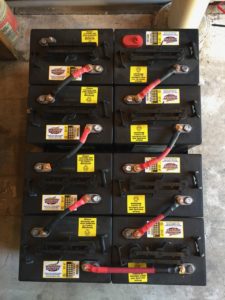
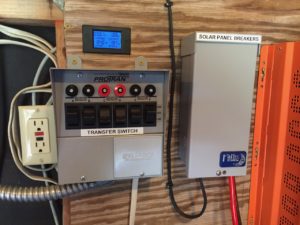
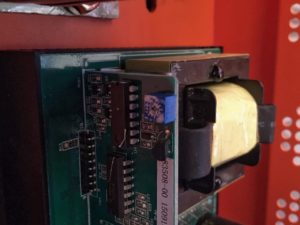
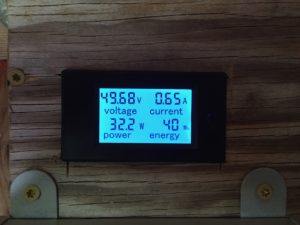


Pingback:Solar Power Rainwater System – More Panels! | Roy Creek Ranch